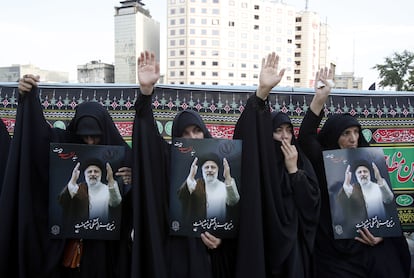Raisi’s death fuels uncertainty in Iran in the midst of its confrontation with Israel
The regime is now forced to hold a new presidential election and risks seeing a new abstention record that would evidence widespread popular discontent


Iranian social networks—from the diaspora, but also from accounts within the country—were filled with memes on Sunday after the announcement of the disappearance of Iranian President Ebrahim Raisi’s helicopter. Even before his death was confirmed, many Iranian users of X (formerly Twitter) were expressing joy at his passing, sharing fragments of movies or videos of people dancing and toasting, with hashtags like #Iranishappy.
But some of those tweets were neither ironic nor funny: they reproduced images of Yina Mahsa Amini, the young Kurdish woman whose death in police custody, after being arrested for wearing the veil incorrectly, sparked protests against the regime in 2022; there were also posts remembering other Iranians who died during the repression of these demonstrations, in which crimes against humanity were committed, according to a United Nations fact-finding mission. At least 550 people died at the hands of Iranian security forces and paramilitaries and another 60,000 were detained. So far, nine men have been hanged in connection with those protests.
میکس و آهنگ عالی به مناسبت سقط شدن رئیسی جلاد #IranIsHappy#RaisiHelicópter#هلیکتلت pic.twitter.com/lvtXA6sHfc
— YoungSheldon (@young_sheldon1) May 20, 2024
With this evident rejection of the late president by a population that is also impoverished — the last official inflation figure was 56% — and in the midst of a confrontation with Israel, exacerbated by the Gaza war and culminating on April 13, when Iran launched an unprecedented attack against Israeli territory, Raisi’s death is pushing the regime towards new elections to elect a new president, at a time when abstention records have been broken in recent votes. In the legislative elections of March 1, only 41% of the 61 million potential voters cast their vote.
In Iran, elections are not synonymous with democracy, but rather a mechanism of competition and distribution of power between elites and factions who are all in favor, to a greater or lesser extent, of the Islamic Republic. Since Raisi’s arrival to the presidency, in 2021, with the votes of only a third of the electorate, that power is almost completely in the hands of the so-called “principlists,” the ultra-conservatives who oppose any reform and defend blind obedience to the Supreme leader.
The only challenge in the last electoral races in Iran has been how to avoid a high abstention rate, since the results are known in advance due to the authorities’ veto of all candidates who are not considered loyal enough. In the March elections, only 30 moderates or reformists — supporters of greater openness of the Islamic regime — were authorized to go to the polls after passing the prior screening of the Guardian Council, while the vast majority of these candidates were disqualified. The Guardian Council is an institution made up of 12 members, half of whom are appointed directly by the Ayatollah Khamenei, while its other six members are nominated, after approval by Parliament, by the Chief Justice, who is himself also directly appointed by the Supreme leader. That institution will also be the one that, in the next presidential elections, decides who can be a candidate and who cannot.
In this system without a democracy, abstention is one of the few ways that citizens have to show their rejection of their leaders, in addition to street demonstrations or criticism on social media. Hence, the low turnout at the polls is viewed as a reproach that delegitimizes the Iranian political system. Above all, because the Islamic Republic of Iran had traditionally used high electoral participation in the past, sometimes greater than 70%, as a demonstration of popular support.
The challenge of preventing a dismally low turnout rate from further undermining the credibility of the regime and Raisi’s future successor is even more pressing following the blow caused by his abrupt death of the head of the Executive. The government needs to avoid sending out an image of fragility. Raisi was not only the president of the country, but one of the names that was mentioned to succeed Khamenei, who turned 85 in April, and whose replacement after his death — the one event that could truly mark the future of Iran or cause a vacuum of power—is now more up in the air than ever.
“We will never know to what extent Raisi was likely to succeed Khamenei, but if he was really being prepared to be a serious contender, then that investment [by the regime] has evaporated,” says Rouzbeh Parsi, head of the Middle East and North Africa program of the Swedish Institute of International Affairs.
From Tehran, the journalist Fereshteh Sadeghi assures, on the contrary, that the deaths of the president and his entourage will not “have serious consequences.” “Iranian politics does not depend on specific people,” she says, and then discards “the usefulness of discussing the succession of the Supreme leader.” The deceased president “was a candidate” to succeed Khamenei, but “no one knew if he was going to be his successor.”
Anniversary of the protests
Raisi’s reelection in the presidential elections that were to have been held in the summer of 2025 was also considered certain. With his disappearance, the certainty of continuity of an ultra-conservative loyalist in the second political position of the Islamic Republic has also disappeared. The date of the next elections to choose the successor of the ill-fated president is unknown, but it should take place within 50 days, which means shortly before the second anniversary of Amini’s death, on September 16, 2022.
The proximity of that anniversary is another element of uncertainty. At the first anniversary of the death of the young Kurdish woman, Iranian security forces repressed any attempt at a demonstration or commemoration, fearing that this date would revive the protests. This situation could unfold again this year. The most recent tweets remembering Amini as people celebrated the death of Raisi show that many Iranians have not forgotten the icon of resistance that she has become.
Despite this, “the Iranian regime is not at a turning point. It is stable,” says Rouzbeh Parsi. “The big question now [with a view to the new elections] is whether the conservatives can unite around a single candidate for president or go back to arguing among themselves, since they normally only agree on marginalizing the reformists and silencing social opposition.”
Meanwhile, the government of Iran was quick to state on Monday that Raisi’s death “will not entail the slightest disturbance in the administration” of the nation. From London, in a conversation on WhatsApp, the Iranian human rights lawyer Shadi Sadr recalls that, despite the attempts of the Iranian authorities to show normality and continuity, the death of the president has once again publicly evidenced the discontent of the population.
“Many Iranians have expressed joy and happiness at the news of Raisi’s death in various ways, including fireworks in some cities such as Saqqez, the hometown of Yina Mahsa Amini, and incessant honking on streets and highways. These reactions are largely due to Raisi’s history of human rights abuses and his participation in the massacre of thousands of political prisoners in 1988,” explains this lawyer. She herself was sentenced in 2010 in absentia to six years in prison and 74 lashes for defending Iranian women who had been sentenced to stoning or other corporal punishments that international law considers torture.
“A Kurd from Saqqez assured this Monday: ‘Your day of mourning is our day of celebration,” summarizes this Iranian lawyer from her exile.
Sign up for our weekly newsletter to get more English-language news coverage from EL PAÍS USA Edition
Tu suscripción se está usando en otro dispositivo
¿Quieres añadir otro usuario a tu suscripción?
Si continúas leyendo en este dispositivo, no se podrá leer en el otro.
FlechaTu suscripción se está usando en otro dispositivo y solo puedes acceder a EL PAÍS desde un dispositivo a la vez.
Si quieres compartir tu cuenta, cambia tu suscripción a la modalidad Premium, así podrás añadir otro usuario. Cada uno accederá con su propia cuenta de email, lo que os permitirá personalizar vuestra experiencia en EL PAÍS.
¿Tienes una suscripción de empresa? Accede aquí para contratar más cuentas.
En el caso de no saber quién está usando tu cuenta, te recomendamos cambiar tu contraseña aquí.
Si decides continuar compartiendo tu cuenta, este mensaje se mostrará en tu dispositivo y en el de la otra persona que está usando tu cuenta de forma indefinida, afectando a tu experiencia de lectura. Puedes consultar aquí los términos y condiciones de la suscripción digital.
More information
Archived In
Últimas noticias
The metaverse, four years later: Is it finished or just at a standstill?
$3,000 and a plane ticket: The United States increases incentives for migrants to self-deport before the end of the year
Charles Dubouloz, mountaineering star, retires at 36 with a farewell tour inspired by Walter Bonatti
From the White House to diplomatic gifts: Lego wins over adult fans, brick by brick
Most viewed
- The low-cost creative revolution: How technology is making art accessible to everyone
- Christian Louboutin: ‘Young people don’t want to be like their parents. And if their parents wear sneakers, they’re going to look for something else’
- All the effects of gentrification in one corner of Mexico’s Colonia Roma
- Christmas loses its festive spirit: ICE fears cast shadow over religious celebrations
- Liset Menéndez de la Prida, neuroscientist: ‘It’s not normal to constantly seek pleasure; it’s important to be bored, to be calm’










































